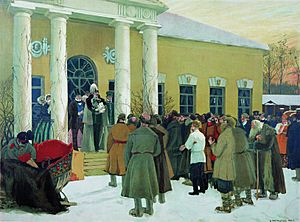Emancipation reform of 1861 facts for kids
The Emancipation Reform of 1861 in Russia was a huge change that freed millions of people. It's also known as the Emancipation Edict. This reform was the first and most important of many new laws passed by Emperor Alexander II of Russia between 1855 and 1881. It officially ended serfdom across the entire Russian Empire.
Contents
What Was Serfdom?
Before 1861, a big part of Russia's population were serfs. Serfs were like farmers who were tied to the land they worked on. They weren't slaves, but they weren't truly free either. They belonged to the noble landowners. Serfs couldn't leave the land without permission. They also had to work for their landlord and often pay them taxes. Their lives were very difficult, and they had few rights. This system had been in place for hundreds of years.
Why Did Russia End Serfdom?
By the mid-1800s, many people in Russia realized that serfdom was holding the country back. Other countries in Europe had already ended similar systems. Russia's economy was falling behind because serfs weren't free to move or work in factories. There were also fears of serf rebellions. Emperor Alexander II knew something had to change. He famously said it was better to abolish serfdom from above than to wait for it to be abolished from below by the serfs themselves.
The Big Change: Freedom for Millions
The Emancipation Manifesto was announced on March 3, 1861. This important document declared that serfs on private estates and household serfs were now free. More than 23 million people gained their liberty! This was a massive step towards modernizing Russia.
With their freedom, serfs gained many new rights. They could now:
- Marry without needing permission from their landlord.
- Own property, like land or a house.
- Start their own businesses.
- Become full citizens with legal rights.
The Land Question
While serfs gained freedom, the issue of land was more complicated. The Manifesto said that peasants would be able to buy the land they had worked on from their former landlords. However, this process was often difficult and expensive. Many peasants struggled to afford the land, and they had to make special payments to the government for many years.
Household serfs, who worked in the landlord's home rather than on the land, were the least lucky. They gained their freedom but received no land at all. This meant they often had to find new ways to make a living, which was very hard.
Emancipation in Other Regions
The reform didn't happen everywhere at the exact same time. In Georgia, for example, serfs were freed a bit later, in 1864. The terms for the nobles in Georgia were often better than in Russia. State-owned serfs, who lived on lands belonging to the Emperor, were freed even later, in 1866.
What Happened Next?
The Emancipation Reform was a huge moment in Russian history. It changed the lives of millions of people and set Russia on a new path. However, it also created new challenges. Many peasants still faced poverty and struggled with land ownership. The reform led to further changes and reforms in Russia over the next few decades.
Images for kids
-
The Abolition of Serfdom in Russia: Work in Freedom is the Foundation of a State (1914), by Alphonse Mucha, The Slav Epic
-
Central Bank of Russia coin commemorating the 150th anniversary of the emancipation reform
See also
 In Spanish: Reforma emancipadora de 1861 en Rusia para niños
In Spanish: Reforma emancipadora de 1861 en Rusia para niños





